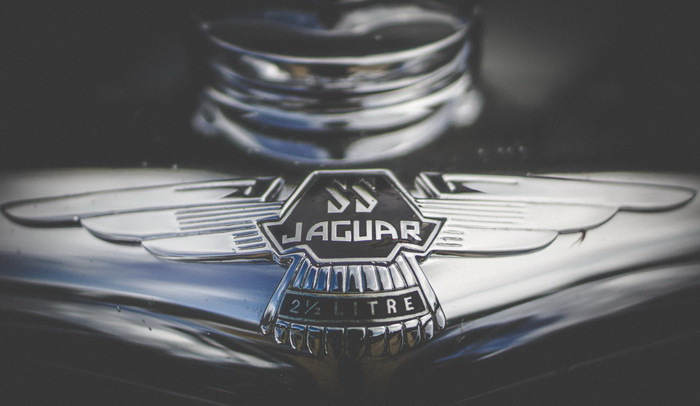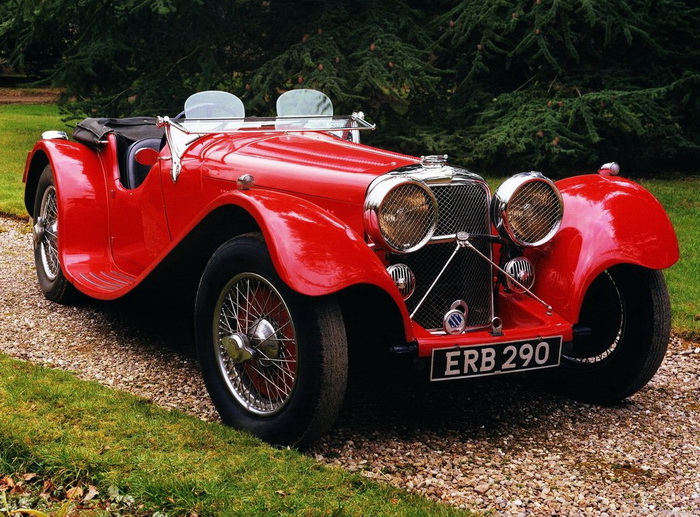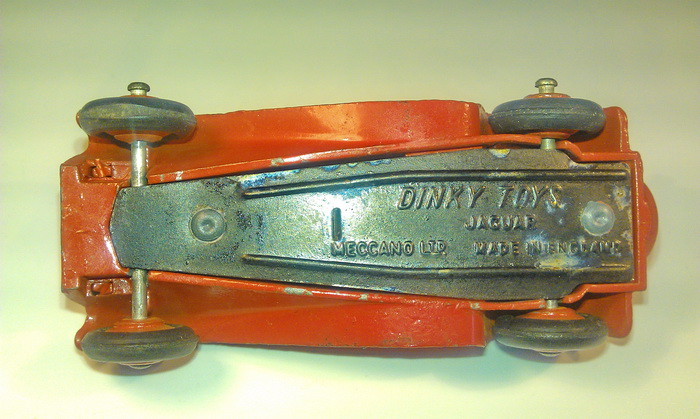--38f and 105 Jaguar SS100 Sports Car (1946-55)
First off is the Jaguar.

Terry
Jan
Sorry I did not reply back sooner....we have a house full of guests at the moment, and very busy around here! But a nice collection of 38 series, along with your usual dose of wonderful additional information....always fun to see all of the catalog illustrations. I also noticed the lack of door detailing when just a youngster, and at that time had no idea of die limitations.
And Chris, also some nice 38's there also. It is interesting to see the earlier, English issues with their more rigid and upright windscreens.....as Jan said, mine are the later, much thinner and more flexible ones. Thanks for posting.......but surely there are more out there.....let's see some others!! Below is a closeup of the Jaguar front grill and headlights, showing some of the wonderful detail present.....

Terry.

Here's mine but with black hubs.
Dave
May be we can build up a complete overview here of all versions and colours.
Here is my contribution, the all light blue, light grey interior, export version:
(See also Michael Driver's article 'Big cats and Dinky Toys' in MC of January 2015 pages 64-67).
Kind regards, Jan
Hi all,
Here is a scarce Jaguar in grey with red hubs.
Kind regards,
Rob 
Hello guys
Here is my Jaguar SS 100 family !

Cheers
Richard
This model deserves some information about the origin of this model. That may be known, but I think it's important for the full history of the model that this be added to the discussion of the model itself. I make this contribution to record the information I could find, especially because it was one of the first cars made by Meccano Liverpool after the war and also one of the first sports cars after the war, but with a very interesting pre-war history.
We know that the model was born before the war. Introduction advertisement of the Dinky Toys series 38 Sports Cars appeared in MM June 1939, together with series 39 Sedans and Coupes, with announcement “Ready August”, but after that no more advertisements appeared about Dinky Toys series 38 till June 1940. WWII was approaching and Meccano Liverpool apparently had more attention for military and aircraft models at that time.

Introduction DT 38f as S.S. “Jaguar” Sports Car in MM June 1939 with announcement “Ready August”.
What we now know, according to Richardson’s DT&MM, is that 3 of the 38 series were actually produced and made available in June 1940, these being 38a Frazer-Nash B.M.W., 38b Sunbeam-Talbot and 38d Alvis. 38c Lagonda and 38f Jaguar were not released until after the war and 38e Triumph Dolomite was never issued but replaced post-war by 38e Armstrong-Siddeley.
The prototype of DT 38f was a SS Jaguar 100. The Jaguar 100 was one of the fastest and best handling sports cars of its day.
Although a fine touring car the SS100 was marketed primarily for competition work. Its first major success came early, if somewhat unexpectedly, when Tommy Wisdom, crewed by his wife, won the arduous Internationale Alpine Trial in 1936, beating Bugatti and bringing the fledgling marque to the attention of the Continental public. This would be the first of many successful racing forays, including class wins in the RAC events of 1937 and 1938. It was also offered as a competition model in the 1937 brochure shown below.

1937 Jaguar SS 100 2,5 litre period competition car. (Photo by courtesy of carandclassic.com/magazine/)

Same 1937 Jaguar SS 100 2,5 litre period competition car - in restored and racing condition. (Photo by courtesy of carandclassic.com/magazine/)

1937 SS Jaguar 100 2,5 Litre radiator badge.

SS Jaguar 100: Wikipedia English
The SS Jaguar 100 is a British 2-seat sports car built between 1936 and 1939 by SS Cars Ltd of Coventry, England.
The manufacturer's name 'SS Cars' used from 1934 maintained a link to the previous owner, Swallow Sidecar, founded in 1922 by Walmsley and Lyons to build motorcycle sidecars. In March 1945 the S. S. Cars shareholders agreed to change the name to Jaguar Cars Limited.
In common with many products of the thirties the adoption of an animal name was deemed appropriate and the model name "Jaguar" was given to a new SS saloon car in 1935, and then to all new SS models.
The '100' was for the theoretical 100 mph maximum speed of the vehicle.
According to found photos and brochures, the prototype of model 38f may be from model year 1936, 37 or 38. The images of the SS Jaguar 100 on these brochures from these years are identical. The date of the Meccano drawing in question is unfortunately not known.

1937 SS Jaguar 100. A publicity shot of CKV250 outside the SS Cars building in 1937. (Photo Wikipedia)
This is considered to be the first recorded use of the Jaguar “leaper” mascot. The CKV 250 car was ordered as a gift for the 16th anniversary birthday of young king Mihai the 1st of Romania. It was equipped with the non-standard fog lights.

1937 SS Jaguar 100 CKV250 of young king Michael I of Romania

1937 brochure SS Jaguar 100 - offered as “competition model”. (Photo courtesy of jag-lovers.org/brochures/)

1938 brochure SS Jaguar 100. (Photo with courtesy of jag-lovers.org/brochures/)
The only brochure I could find with the two secondary aero windscreens as fitted on DT 38f.

When new the SS100 2½-litre cost £395, and even the 3½-litre cost only £445, making it the cheapest 100mph car in Britain at the time. A total of 191 of the 2½-litre cars were built between 1935 and 1939, with additionally 118 of the 3½-litre variant that was built from 1938 onwards, for a total production figure of 309 cars.

A 1938 SS Jaguar 100 - 2 1⁄2 Litre with the main windshield up, part of the Jaguar Heritage Collection kept at the British Motor Museum. (Photo Wikipedia English)

Same 1938 SS Jaguar 100 with the two secondary aero windscreens and main folded windshield down

38f Jaguar with 2 rounded aerodanamic windshields
38f is the only sports car of Meccano Liverpool fitted with 2 separate windshields. All other sport or touring cars have a full windshield or full window frame.
I think that Meccano Liverpool, with these 2 separate aerodynamic windscreens, wanted to distinguish the 38f from the other sports cars as a real competition car, like the real Jaguar 100 competition car. That's why the twin blended note horns, as pictured in the brochures, should not be missing on model 38f as a characteristic part of the Jaguar 100 competition car. You can also see from the rounded bucket seats that it is a competition model. A tourer model has seats with rectangular backrests.

1938 Jaguar S100 ERB 290 in Jaguar Daimler Heritage Trust

38f Jaguar

Dinky Toys 38f Jaguar Sports Car pre-war Wooden Prototype green Christie's 24-9-2001. Now owned by Vincent Espinasse.
Note the smooth hubs, crimped axles and white tyres. The absence of the twin blended note horns (as fitted in the brochures and on DT 38f) on the front of the mock-up is striking.
After the war, production at Meccano Liverpool slowly started again and the arrival of the first new models, included 153a Jeep, 38c Lagonda and 38f Jaguar Sports Car was announced in MM October 1946, but first available in November 1946.

Dinky Toys 38f Jaguar Sports Car in MM November 1946 with header “Now available!”.

First 3 Dinky Toys cars produced after the war – 153a Jeep, 38c Lagonda Sports Coupé and 38f Jaguar Sports Car

Meccano price list November 1946 with for the first time 38f Jaguar Sports Car included
Model 38f first appeared after the war in Meccano UK price list of November 1946 and last in Meccano price list of October 1948 so it was available in UK for only 2 years. It did not appear in any UK Dinky Toys catalogue at all. 38f appeared in the Dutch catalogues up to and including 1952. In the renumbering period, 38f received sales number 105 and was only intended for export to the USA and appeared in the USA catalogue up to and including 1956. This shows that exports were very important for Meccano Liverpool as well as for all other British companies. 'Export or Die!' was the government's imperative.

Renumbering series 38 including 38f Jaguar Sports Car to 105 in 1954 USA catalogue

38f Jaguar Sports Car – export version with red ridged hubs.
The models for the British home market got black coloured hubs. The export models got coloured hubs equal to the body colour or else. The 2 transparent windshields are fixed as one whole with a lip in a slit in the base plate. Some have a silver rim.

38f base plate with Jaguar brand name without sales number. Note the slot in the base plate to secure the windshields lip.
The baseplate is always black. I could not find a 38f with a closed solid steering wheel as with my 38c Lagonda. Richardson lists the following casting changes on the drawing page of 38f: 28.10.47 front mudguards strengthened; 18.11.52 strengthened further. Are these casting changes visible?? I only have one example.

My 38f Jaguar with open steering wheel with red ridged hubs and black smooth tyres with my 38c Lagonda with closed solid steering wheel and black smooth hubs with smooth white tyres
There are many colour variants. I found a picture of a 38f with a rare colour from the Remy Meeus collection auctioned at Chritie's on 24-9-2001. 38f was released in a trade box of 6 pieces. I found a photo from Rob van der Hoort of 2 trade boxes 38f and 105/38f USA export with red label in topic Trade Boxes. It seems that 105/38f with the other series 38 were sold to the last in a trade box of 6 pieces and did not receive an individual box after the renumbering.

38f Remy Meeus collection auctioned at Chritie's on 24-9-2001. It’s a first issue with smooth hubs. It has domed axles.

Trade box 38f and 105/38f export USA with red label from Rob van der Hoort in topic Trade Boxes
38f replica as a memory to Mike and Sue Richardson:
Surfing I came across the auction on Ebay UK of this 38f Jaguar SS100 model issued by Maidenhead Static Model Club (MSMC) number 12. It is a replica of Dinky Toys 38f Jaguar SS100 issued on Christmas 2013 as a memory to Mike and Sue Richardson. Information elsewhere tells that there only 90 of this special model were made. I think the photos of this should not be missing in this topic.

38f Jaguar SS100 replica model of Dinky Toys 38f Jaguar SS100 of MSMC from Christmas 2013 as a memory to Mike and Sue Richardson. Photo Ebay UK.
I like Jaguar cars very much and I'm happy the Jaguar car brand name still exists, although sadly it is no longer wholly British owned.
I note that the start of issue title above this topic should read 1946 instead of 1940.
Jan Oldenhuis 20 February 2023.
Hi Jan, nice contribution. I managed to change the date in the header! Kind regards, Jan W
Jan--Another very thorough and very nicely done writeup on this most interesting car and Dinky Toys model. I have always had particular liking and fondness for the Dinky model, as I had a red one given to me for Christmas in 1951......one of first five Dinky Toys. I am also a huge Jaguar fan, and have many books on the marque. As a young boy in Southern California, I got to see many of them race in local sports car races, and the D-Type is my favorite race car. Meccano certainly made a very nice and quite accurate model of this dashing sports car.
Best regards, Terry
Terry, thank you very much for your wonderful memories. Jan, thanks for your nice comment and the correction in the header.
Kind regards, Jan O










-073 Land Rover, Horse Box and Horse (1960-67)
DTCAwebsite upgrade 2023
DTCAwebsite upgrade 2023
-105c and 383 4-Wheel Hand Truck (1949-1958)
-105c and 383 4-Wheel Hand Truck (1949-1958)
DTCAwebsite upgrade 2023
DTCAwebsite upgrade 2023
DTCAwebsite upgrade 2023
DTCAwebsite upgrade 2023
DTCAwebsite upgrade 2023
DTCAwebsite upgrade 2023
DTCAwebsite upgrade 2023
DTCAwebsite upgrade 2023
DTCAwebsite upgrade 2023
DTCAwebsite upgrade 2023
DTCAwebsite upgrade 2023
DTCAwebsite upgrade 2023
DTCAwebsite upgrade 2023
--22c Motor Truck (1933-50)
--22c Motor Truck (1933-50)
DTCAwebsite upgrade 2023
DTCAwebsite upgrade 2023
Trailer Caravans
Trailer Caravans
DTCAwebsite upgrade 2023
DTCAwebsite upgrade 2023
DTCAwebsite upgrade 2023
DTCAwebsite upgrade 2023
Trailer Caravans
Trailer Caravans
-138 Hillman Imp (1963-73)
-537 Renault 16 TL
-189 Triumph Herald Saloon (1959-64)
-255 Mersey Tunnel Police Van (1955-61)
DTCAwebsite upgrade 2023